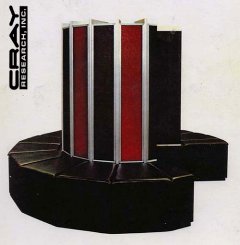 |
|
Cray-1 |
BOXEN
According to The Jargon File,
"boxen" is defined as:
Fanciful plural of box often encountered in the phrase 'Unix boxen',
used to describe commodity Unix hardware.
MY BOXEN
I know to many of you this'll seem pretty geeky... to others, it'll seem
rather dull and ho-hum, or even unimpresive. But just like pet-owners or
car enthusiasts, we computer geeks can be rather proud of our chosen
passion, even when we haven't invested much money.
I've been into computers to some degree for about 20 years as of this writing,
though admittedly early on I was just a kid playing with Basic and a handful
of small DOS-based games on an original IBM PC with a 4.77MHz 8088 CPU.
One of the remaining driving forces for me to keep upgrading hardware these
days is games, since unlike years ago, other applications aren't quite as
dependant on hardware limitations.
However, with periodic upgrades of my main desktop PC, I've always used the
left-over parts to build additional machines. In turn, these other boxen
have benefitted from the hand-me-down parts with additional upgrades to my
workstation. As a result, I have a large number of machines, but they
cross the spectrum of the history of my upgrades, and vary in obsolescence.
Even so, they remain useful under linux, and in many cases are still
under-utilized. Currently, the slowest "server" in the rack is a dual
Pentium2 450MHz machine, which sits idle most of the time. There's an
even slower one in there too, but it's not a server. It's configured
for DOS, and is merely a 200MHz Pentium-MMX. Also, the box that acts
as the network router "appliance" and firewall is a 300MHz Celeron.
I take great amusement, however, in knowing that even my slower computers,
as old and obsolete as they are now compared to current PC hardware, stack
up quite nicely in comparison to the super-computers I read about as a kid.
Compare the following, for example:
|
The first Cray-1 Supercomputer, Installed in Los Alamos in 1976:
- Speed: 133 MFLOPS (peak 250) / 160 MIPS
- 80 MHz CPU Clock
- 64-bit Word Size
- 8 Megabytes RAM (50 ns)
- Weight: 5.5 Tons including cooling
- Power: 115 kW excluding cooling
- Cost: $8.8-Million in 1976 dollars, excluding the disks
| | | |
My aging 200-MHz Pentium-MMX (from roughly 1996):
- Speed: Approximately 25-80 MFLOPS? 200 MIPS?
(estimates, hard to research)
- 200 MHz CPU Clock
- 32-bit Word Size
- 96 Megabytes RAM (probably 16 originally)
- Cost: Given to me for free, since it was already obsolete
|
As you can see, the 200MHz Pentium would have to work longer to accomplish the
same tasks as a Cray-1 (particularly when you take into account the optimizations that the Cray had for mathematical and scientific data processing), but similar tasks are within it's reach. At the time that
the Pentium was produced, 96 MB of RAM would have been a luxury; However 16 or 32
MB would have been fairly common. I remember using about 48MB in my 150MHz machine
for a while before upgrading to a new processor class.
The Cray-1 had over 200,000 logic gates, roughly similar to the Intel 386
from the 1980s. However, the Cray-1's logic was constructed with simple NAND ICs,
without a microprocessor chip.
(see more on wikipedia).
Yesterday's supercomputer, today's desktop, tomorrow's trash. :)
BOXEN DETAILS
I've debated with myself over how much information to divulge about the
nature of my network and my machines, and have waffled back and forth on it.
Recently I ended up password-protecting some of my online status pages, but
I figure there's not much harm in showing how obsolete my equipment is. :)
There's also probably little harm in a simple Network Diagram.
When you're supporting the network needs of a single person
using linux, you generally don't need much hardware at all. Granted, I'm
burning more electricity with the multiplicity of hardware, but older machines
that are idle will also draw a lot less power than more powerful machines that
will be even more idle, even though the newer performance-per-watt figures are superior.
The older machines generally had lower idle power consumption.
Typically not pictured here are Liche and Vampire (desktops).
Reaper
- Xen Guest on Banshee (Slackware)
- Network Services: DHCP, SMTP, HTTP, POP
- DNS Auth/NS Server
- DNS Caching Resolver
- Primary File Server, NFS/SMB, 2+ TB raw storage
- Weather Station
- UPS Monitor for rack
- Configuration manager for LAN, DNS, Router, etc
Banshee
- Intel Core i5 750
- Xen Host (CentOS)
- Secondary log host
- DNS Auth/NS Server
Ghoul
- Xen Guest on Banshee (Windows XP)
- Windows Server
Weather Radar
Music Server (iTunes for Roku)
Vampire
- Intel Core 2 Quad
- Windows Workstaton
Spook